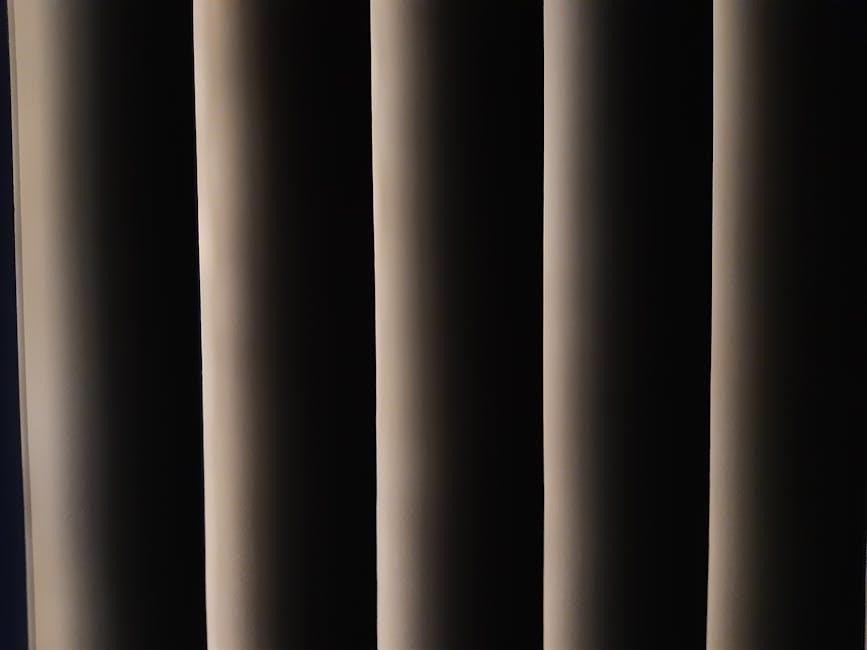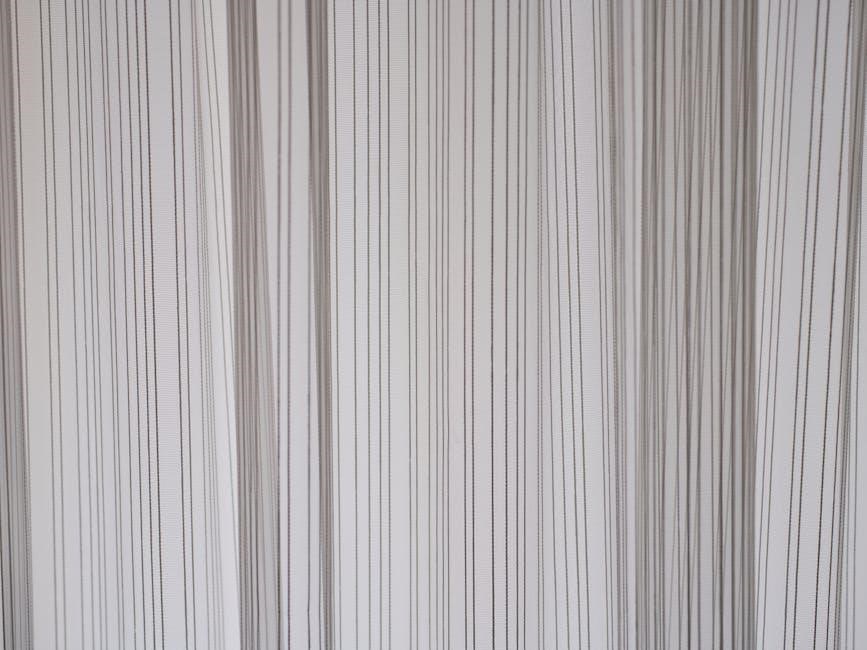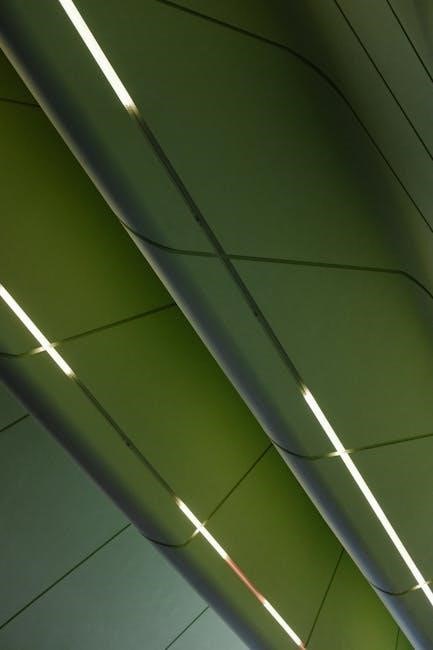Parallel lines cut by a transversal form pairs of angles, including corresponding, alternate interior, and alternate exterior angles, which are key to understanding geometry. Supplementary angles are also crucial in these configurations, often leading to congruent or equal measures. These relationships are fundamental for solving problems and proving theorems in geometry. Worksheets and resources like those from Infinite Geometry and KutaSoftware provide practical exercises to master these concepts. Regular practice with PDF worksheets helps solidify understanding of angle relationships and their applications in real-world scenarios, making them essential tools for students and educators alike;
Definition of Parallel Lines and Transversals
Parallel lines are lines that never intersect and remain equidistant from each other. A transversal is a line that intersects two or more lines. When a transversal cuts parallel lines, it forms pairs of angles, such as corresponding, alternate interior, and alternate exterior angles. These angles are either congruent or supplementary, depending on their positions. Understanding these definitions is crucial for analyzing angle relationships and solving geometry problems. Worksheets like those from Infinite Geometry and KutaSoftware provide exercises to practice identifying and classifying these elements, helping students master foundational geometry concepts effectively.
Importance of Understanding Angle Relationships
Understanding angle relationships formed by parallel lines cut by a transversal is fundamental in geometry. These relationships help identify corresponding, alternate interior, and alternate exterior angles, which are essential for proving lines parallel and solving equations. They also aid in calculating unknown angle measures and justifying geometric theorems. Mastery of these concepts is critical for advanced math and real-world applications, such as architecture and engineering. Worksheets from Infinite Geometry and KutaSoftware offer practical exercises, enabling students to apply these principles confidently and accurately. Regular practice ensures a strong foundation in geometry, benefiting students in their academic and professional pursuits.

Key Concepts and Properties
Parallel lines cut by a transversal exhibit unique angle relationships, including corresponding, alternate interior, and same-side angles. These properties are fundamental for solving geometric problems and proving theorems.
Corresponding Angles
Corresponding angles are formed when a transversal intersects two parallel lines, creating pairs of angles in identical positions relative to the lines. These angles are equal in measure because the parallel lines are cut by the same transversal, resulting in congruent angles. This fundamental property is crucial for solving problems involving parallel lines and transversals. Worksheets often include exercises where students identify and measure corresponding angles to find unknown angle measures or verify angle relationships. Understanding corresponding angles is essential for applying geometric principles and proving theorems related to parallel lines. They form the basis for more complex angle relationships in geometry.
Alternate Interior Angles
Alternate interior angles are pairs of angles located inside the two parallel lines and on opposite sides of the transversal. These angles are equal in measure when the lines are parallel, as the transversal creates identical spatial relationships. This property is vital for solving geometric problems and proving theorems. Worksheets often include diagrams where students identify and work with alternate interior angles to find unknown measures or establish angle relationships. Understanding these angles is foundational for advanced geometry concepts and real-world applications, such as designing roadways or analyzing structural symmetry. They provide a reliable method for determining angle congruence in parallel line configurations.
Alternate Exterior Angles
Alternate exterior angles are angle pairs located outside the two parallel lines and on opposite sides of the transversal. These angles are equal when the lines are parallel. This property is essential for solving geometric problems and proving theorems. Worksheets often include diagrams where students identify and use alternate exterior angles to determine unknown angle measures. Understanding these angles is crucial for advancing in geometry and solving complex spatial problems. They provide a consistent method for establishing angle congruence in various configurations involving parallel lines and transversals.
Same-Side Interior and Exterior Angles
Same-side interior and exterior angles are angle pairs formed when a transversal intersects two parallel lines. Same-side interior angles are located inside the parallel lines on the same side of the transversal, while same-side exterior angles are outside the parallel lines on the same side. Both pairs of angles are supplementary, meaning they add up to 180 degrees. This relationship is crucial for solving geometric problems and understanding the properties of parallel lines cut by a transversal. Worksheets often include exercises where students identify and use these angle pairs to find unknown angle measures, enhancing their ability to apply geometric principles effectively.
Types of Angle Pairs

Angle pairs formed by parallel lines and a transversal include corresponding, alternate interior, and alternate exterior angles. These pairs are either supplementary or congruent, aiding in problem-solving.
Supplementary and Congruent Angles
When parallel lines are cut by a transversal, angle pairs can be supplementary or congruent. Supplementary angles, like same-side interior angles, add up to 180°, forming straight lines. Congruent angles, such as corresponding angles, are equal in measure due to the parallel lines. These properties are fundamental for solving problems involving angle measures. Understanding these relationships is crucial for identifying and calculating unknown angles in geometric figures. Supplementary and congruent angles provide a basis for proving theorems and solving real-world geometry problems, making them essential concepts in studying parallel lines and transversals.
Vertical Angles and Their Properties
Vertical angles are formed when two lines intersect, creating pairs of opposite angles. These angles are equal in measure due to the vertical angle theorem. In the context of parallel lines cut by a transversal, vertical angles are also formed at each intersection. They are supplementary to adjacent angles, adding up to 180°. Understanding vertical angles is crucial for solving problems involving parallel lines and transversals. They provide a reliable way to find unknown angle measures by leveraging their equality. Vertical angles are a key concept in geometry, offering a consistent method for verifying angle relationships in various configurations.
Classifying Angle Pairs
Classifying angle pairs formed by parallel lines cut by a transversal involves identifying their positions and relationships. Corresponding angles are equal and located in the same position relative to the transversal. Alternate interior angles are equal and found inside the lines on opposite sides of the transversal. Alternate exterior angles are also equal and located outside the lines on opposite sides. Same-side interior angles are supplementary, as are same-side exterior angles. Understanding these classifications helps in applying the correct properties to determine angle measures and relationships in geometric problems.

Theorems and Proofs
The Parallel Lines Cut by a Transversal Theorem states corresponding angles are equal. Its converse proves parallelism if corresponding angles are equal. Proofs often involve supplementary angles.
Parallel Lines Cut by a Transversal Theorem
The Parallel Lines Cut by a Transversal Theorem states that if two parallel lines are cut by a transversal, then the corresponding angles are equal. This fundamental theorem is crucial for understanding angle relationships in geometry. It provides a basis for solving problems involving parallel lines and transversals, such as determining unknown angle measures or proving the parallelism of lines. The theorem is widely used in various applications, including architecture, engineering, and everyday geometric scenarios. By mastering this theorem, students can better analyze and solve complex problems involving parallel lines and transversals in their worksheets and real-world situations.
Converse of the Theorem
The converse of the Parallel Lines Cut by a Transversal Theorem states that if two lines are cut by a transversal and the corresponding angles are equal, then the lines are parallel. This converse is equally important, as it provides a method to prove that lines are parallel by showing the equality of corresponding angles. It is widely applied in geometric proofs and problem-solving, particularly in worksheets involving parallel lines. By understanding this converse, students can effectively determine the parallelism of lines based on angle relationships, enhancing their ability to solve complex geometry problems.
Proofs Involving Supplementary Angles
Proofs involving supplementary angles are fundamental in geometry, particularly when working with parallel lines cut by a transversal. When two lines are parallel, the same-side interior and exterior angles formed by a transversal are supplementary, meaning they add up to 180 degrees. This property is crucial for proving the parallelism of lines or determining unknown angle measures. For instance, if two same-side interior angles are found to be supplementary, it confirms the lines are parallel. Such proofs rely on the transversal theorem and are essential for solving problems in worksheets involving parallel lines and transversals.

Solving for Angle Measures
Solving for angle measures involves using properties of corresponding, alternate interior, and same-side interior angles. Set up equations based on supplementary angles (sum of 180 degrees) to find unknown measures.
Using Corresponding Angles to Find Unknowns
Corresponding angles are equal when parallel lines are cut by a transversal. To find unknowns, identify pairs of corresponding angles and set up equations based on their equality. For example, if one angle measures 45 degrees, its corresponding angle also measures 45 degrees. This property simplifies solving for unknown angle measures in diagrams. Always label angles clearly and refer to their positions relative to the transversal and lines. Practice worksheets often include diagrams where corresponding angles are highlighted, making it easier to apply this concept effectively. Ensure accuracy by double-checking angle pair relationships before solving.
Applying Alternate Interior and Exterior Angles
Alternate interior angles are equal when parallel lines are cut by a transversal, while alternate exterior angles are also equal; These properties are crucial for solving unknown angle measures. For instance, if one alternate interior angle measures 30 degrees, its pair will also measure 30 degrees. Similarly, alternate exterior angles will be equal in measure. When working on worksheets, identify these angle pairs and set up equations based on their equality. Practice diagrams often highlight these relationships, making it easier to apply the concept. Always verify angle positions relative to the transversal and lines to avoid errors in calculation.
Solving Equations Involving Angle Pairs
Solving equations involving angle pairs requires understanding their relationships. When parallel lines are cut by a transversal, corresponding angles are equal, and supplementary angles sum to 180 degrees. For example, if two corresponding angles are known, their measures can be set equal to solve for unknowns. Similarly, same-side interior angles are supplementary, allowing users to write equations like ( x + 45^ rc = 180^ rc ). Practice worksheets often provide diagrams with labeled angles, making it easier to identify pairs and set up equations. Always verify angle relationships before solving to ensure accurate results and avoid common mistakes.

Classifying Angles in Worksheets
Worksheets on parallel lines involve identifying angle types (corresponding, alternate interior, etc.) and classifying them as equal or supplementary, ensuring clear and accurate angle classification.
Identifying Angle Pairs in Diagrams
In worksheets involving parallel lines and transversals, identifying angle pairs is crucial. Start by locating the transversal and its intersection points with the parallel lines. Label each angle formed, focusing on pairs like corresponding, alternate interior, and alternate exterior angles. Use colors or symbols to highlight relationships, ensuring clarity. Practice distinguishing between equal and supplementary angles. Common mistakes include mislabeling angles or confusing their positions. Accurate identification is key for solving problems and understanding properties. Regular practice with diagrams enhances spatial reasoning and familiarity with angle relationships.
Labeling and Naming Angles
Labeling and naming angles accurately is essential for clarity in geometry problems. Begin by identifying the vertex of each angle, typically where two lines intersect. Use a consistent naming convention, such as labeling angles clockwise or counter-clockwise. Assign numbers or letters to each angle based on their position relative to the transversal and parallel lines. For example, name angles at the top left as Angle 1 and proceed sequentially. Use notation like ∠A or ∠B to denote specific angles. Clear labeling helps in identifying corresponding, alternate, and supplementary angles. Practice this skill to enhance problem-solving efficiency and understanding of angle relationships.
Writing Equations Based on Angle Relationships
Writing equations based on angle relationships involves identifying pairs of angles formed by parallel lines and a transversal. Corresponding angles are equal, so their measures can be set as equal in an equation (e.g., ∠A = ∠B). Alternate interior angles are also congruent, allowing similar equations. Supplementary angles, such as same-side interior angles, add up to 180 degrees, enabling equations like ∠C + ∠D = 180°. Using these properties, students can set up and solve equations to find unknown angle measures. Practice worksheets often include diagrams where these relationships can be applied to write and solve equations accurately.

Common Errors and Misconceptions
Students often confuse alternate interior and corresponding angles, incorrectly assuming they are equal. Another common mistake is misidentifying supplementary angles or miscalculating their sums as 180°.
Mistaking Alternate and Corresponding Angles
A common error occurs when students confuse alternate interior angles with corresponding angles. Both pairs are equal when lines are parallel, but their positions differ. Corresponding angles are in matching positions relative to the transversal, while alternate interior angles are inside the lines but on opposite sides. Misidentifying these can lead to incorrect conclusions about angle relationships. For example, assuming alternate interior angles are corresponding can result in wrong angle measures. Understanding their distinct positions is crucial for accurate theorems and proofs. Teachers often highlight this in worksheets to ensure clarity and prevent confusion in geometric principles and calculations.
Incorrectly Identifying Supplementary Angles
A frequent mistake involves incorrectly identifying supplementary angles when working with parallel lines cut by a transversal. Supplementary angles sum to 180 degrees, but students often confuse which pairs are supplementary. For example, same-side interior angles are supplementary, but corresponding or alternate angles are not. This error stems from misapplying angle relationships. To avoid confusion, it’s essential to carefully label and identify the specific angles formed by the transversal and parallel lines. Practicing with diagrams and worksheets helps reinforce correct identification, ensuring accurate problem-solving in geometry and related fields. Proper understanding is key to mastering theorems and proofs involving parallel lines.
Common Calculation Mistakes
When solving problems involving parallel lines cut by a transversal, students often make calculation errors. One common mistake is incorrectly adding or subtracting angle measures, leading to wrong conclusions about angle relationships. For example, miscalculating supplementary angles (which sum to 180 degrees) or misapplying properties of corresponding or alternate angles can result in incorrect solutions. Additionally, errors in setting up equations for unknown angles can compound problems. To avoid these mistakes, it’s crucial to carefully label angles, double-check arithmetic, and ensure a solid understanding of angle relationships. Regular practice with worksheets helps build accuracy and confidence in solving geometry problems effectively.

Real-World Applications
Parallel lines and transversals are essential in railroad track design, ensuring safe distances and alignments. They also guide highway dividers and construction layouts, promoting structural integrity and safety.
Architecture and Construction
In architecture, parallel lines and transversals are fundamental for designing symmetrical structures, such as bridges and buildings. They ensure alignment and balance in blueprints, preventing structural instability. For instance, parallel beams in ceilings and floors maintain uniform load distribution. Architects use corresponding and alternate angles to create visually appealing designs, like evenly spaced columns or staircases. Construction engineers rely on these principles to align materials accurately, ensuring safety and durability. Misalignment can lead to costly repairs, making understanding parallel lines crucial in real-world applications.
Physics and Engineering
In physics, parallel lines and transversals are essential for understanding vector forces and light rays. For example, parallel forces acting on objects can be analyzed using corresponding angles to determine equilibrium. In optics, parallel light rays bending through lenses rely on angle relationships. Engineers use these principles to design railways, ensuring tracks remain parallel for safety. Similarly, conveyor belts and cable systems depend on aligned parallel lines. Misalignment can cause mechanical failures, making precise angle calculations critical. These concepts also apply to bridge and tunnel designs, where structural integrity relies on parallel alignments. Understanding these relationships is vital for innovation and safety in engineering applications.
Everyday Geometry Scenarios
Parallel lines cut by a transversal appear frequently in everyday life. Railroad tracks, zebra crossings, and stair railings are common examples. Understanding angle relationships helps measure distances, like the width of a river between parallel banks. In cooking, aligning utensils or ingredients in parallel rows ensures even distribution. Parking lot stripes and highway markings rely on these principles for safety. Even in sports, such as basketball courts or tennis fields, parallel lines guide gameplay; Recognizing these patterns enhances problem-solving skills, making geometry practical and accessible in routine tasks. These real-world applications highlight the importance of mastering angle relationships for daily efficiency and accuracy.

Worksheet Design and Resources
Effective worksheets on parallel lines and transversals include puzzles, interactive activities, and real-world problems to engage students and reinforce angle relationship concepts for teachers and learners.
Creating Effective Practice Worksheets
Effective practice worksheets on parallel lines and transversals should include a variety of problem types, such as identifying angle pairs, solving for unknown measures, and applying theorems. Incorporate visual diagrams with labeled lines and angles to help students visualize relationships. Use clear instructions and examples to guide learners. Include a mix of basic and advanced problems to cater to different skill levels. Add step-by-step solutions for selected questions to reinforce understanding. Consider adding interactive elements like fill-in-the-blank or matching activities to engage students and promote active learning. Ensure the worksheet is well-organized and visually appealing for optimal learning outcomes.
Free PDF Resources for Teachers and Students
Free PDF resources are widely available for teachers and students to practice parallel lines and transversals. Websites like MathWorksheets4Kids and Teachers Pay Teachers offer downloadable worksheets with various problem sets. These PDFs often include guided notes, diagrams, and step-by-step solutions, making them ideal for independent study or classroom use. Teachers can customize some resources to fit specific curriculum needs. Students benefit from clear explanations and exercises that reinforce angle relationships, such as corresponding and alternate angles. These resources are invaluable for reinforcing concepts and ensuring mastery of parallel line properties.
Interactive Tools for Learning
Interactive tools enhance learning for parallel lines and transversals by providing visual and hands-on experiences. Platforms like GeoGebra and Khan Academy offer dynamic simulations where students can explore angle relationships. Tools like CK-12 include interactive diagrams and step-by-step problem solvers. These resources allow students to move transversals, observe angle changes, and test hypotheses. Teachers can use these tools for demonstrations, while students can practice independently. Interactive simulations make abstract concepts like corresponding and alternate angles more concrete, fostering deeper understanding and engagement. These tools are especially effective for visual learners and those needing additional practice.

Practice Problems and Solutions
Practice problems and solutions are essential for mastering parallel lines and transversals. Worksheets and PDFs provide exercises with step-by-step solutions, helping students clarify concepts through practical examples.
Measuring and Classifying Angles
Measuring and classifying angles formed by parallel lines cut by a transversal is a fundamental skill. Worksheets often provide diagrams with numbered angles, asking students to measure them using protractors and classify them as corresponding, alternate interior, or same-side interior angles. This practice helps in understanding the relationships between angles and verifying properties like congruence and supplementary angles. Students learn to identify and label angles correctly, ensuring accurate measurements and classifications. These exercises are crucial for building a strong foundation in geometry and preparing for more complex problems involving angle relationships and theorems.
Solving for Unknown Angle Measures
Solving for unknown angle measures involves using properties of parallel lines and transversals. Worksheets often provide diagrams with some angles labeled and others missing. Students use corresponding angles, alternate interior angles, or same-side interior angles to set up equations. For example, if two corresponding angles are known, the unknown angle can be found by recognizing their congruence. Similarly, supplementary angles can be used to solve for missing measures by setting their sum to 180 degrees. These exercises enhance problem-solving skills and reinforce understanding of angle relationships in geometry. Accurate measurements and logical reasoning are essential for correct solutions.
Advanced Problem-Solving Strategies
Advanced problem-solving strategies for parallel lines cut by a transversal involve applying multiple theorems and properties simultaneously. Students can use algebraic methods to solve for unknown angles when multiple transversals intersect parallel lines. Recognizing patterns in angle relationships and systematically applying corresponding, alternate, and supplementary angle properties can simplify complex problems. Advanced techniques also include proving statements about angle measures using two-column or paragraph proofs. These strategies enhance critical thinking and prepare students for more complex geometry concepts. By mastering these approaches, learners can efficiently solve challenging problems involving parallel lines and transversals.
Mastery of parallel lines cut by a transversal is foundational for geometry. Regular practice and analysis of worksheet problems ensure long-term proficiency and conceptual clarity.
Summarizing Key Concepts
Encouraging Further Practice
Consistent practice is essential to mastering parallel lines and transversals. Utilize worksheets, such as those found in PDF resources, to reinforce concepts like corresponding angles and supplementary relationships. Encourage students to create their own problems or use online tools for interactive learning; Regular review, even for a few minutes daily, strengthens understanding. Group study sessions or peer tutoring can also foster engagement. By dedicating time to practice, students develop problem-solving skills and confidence in geometry. Make practice a routine part of learning to ensure long-term success with parallel lines and transversals.
Final Tips for Mastery
To truly master parallel lines and transversals, focus on understanding the “why” behind the properties. Regularly review key theorems and their proofs to build a strong foundation. Practice identifying angle pairs in real-world scenarios, like railroad tracks or building structures, to deepen your intuition. Use online tools or apps to visualize problems and explore interactive examples. Teach the concepts to someone else to reinforce your own understanding. Finally, stay organized by keeping a notebook of solved problems and key insights for quick reference. Consistency and curiosity are your keys to lasting mastery.



